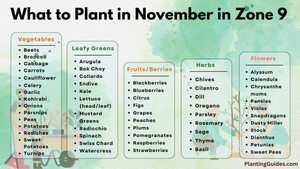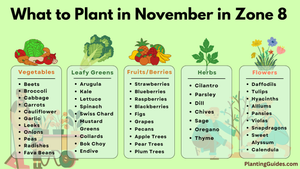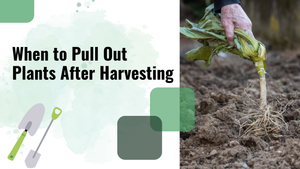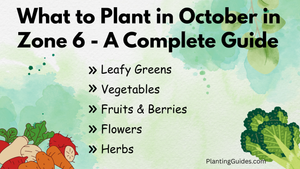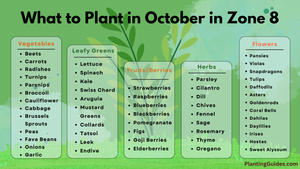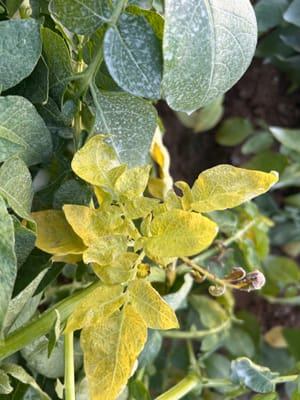
Have you ever stood in your backyard holding a packet of seeds, thinking, “Is this the right time to plant this?” Or maybe you've tried to grow tomatoes in July only to watch them fry in the East Texas sun. If that sounds familiar, you are not alone, and you are in the right place.
I have collected tips and advice from many places, both online and offline. And from all that, I have realized one thing: if you know what to plant and when, East Texas can be a fantastic place for gardening.
That's why I have created this easy-to-follow planting schedule based on everything I have learned, and it's made to actually work in East Texas.
To make things simple and crystal clear, I have grouped everything into five easy-to-follow categories.
- Leafy Greens
- Vegetables
- Fruits & Berries
- Flowers
- Herbs
Each section comes with an easy-to-read planting table and a helpful visual chart that shows the most important info, like the best time to plant, when to transplant, when you can expect your first harvest or flowers, and even which varieties grow best in East Texas soil.
Note: It really took a lot of time to build these visual charts. Please subscribe to this site so that I can bring more helpful content for East Texas gardeners.
East Texas Planting Schedule - Charts (Printable PDF version)
Leafy Greens in East Texas
Leafy greens grow best when the weather is cool in East Texas. If you plant them at the right time, you can enjoy fresh salads and cooked greens for almost 9 months a year.
The best time to plant leafy greens is in late winter or early fall, when it’s not too hot. Avoid planting in the middle of summer, because the heat makes them grow flowers too soon and ruins the taste.
| Leafy Green | Best Planting Time | Planting Method | Transplanting Time | First Harvest | Variety Recommendations |
|---|---|---|---|---|---|
| Collard Greens | Feb–Apr, Aug–Oct | Direct sow | N/A | 60–85 days | Georgia Southern |
| Kale | Feb–Mar, Aug–Oct | Start indoors or direct | 3–4 weeks after sowing | 50–65 days | Lacinato, Dwarf Curled |
| Lettuce | Feb–Mar, Sep–Nov | Direct sow / Transplant | 2–4 weeks after sowing | 30–45 days | Buttercrunch, Romaine |
| Mustard Greens | Feb–Mar, Sep–Nov | Direct sow | N/A | 30–40 days | Southern Giant Curled |
| Spinach | Feb–Mar, Oct–Nov | Direct sow | N/A | 40–50 days | Bloomsdale, Space |
| Swiss Chard | Feb–Apr, Sep–Oct | Direct sow | N/A | 50–60 days | Bright Lights, Fordhook |
Visual Chart:
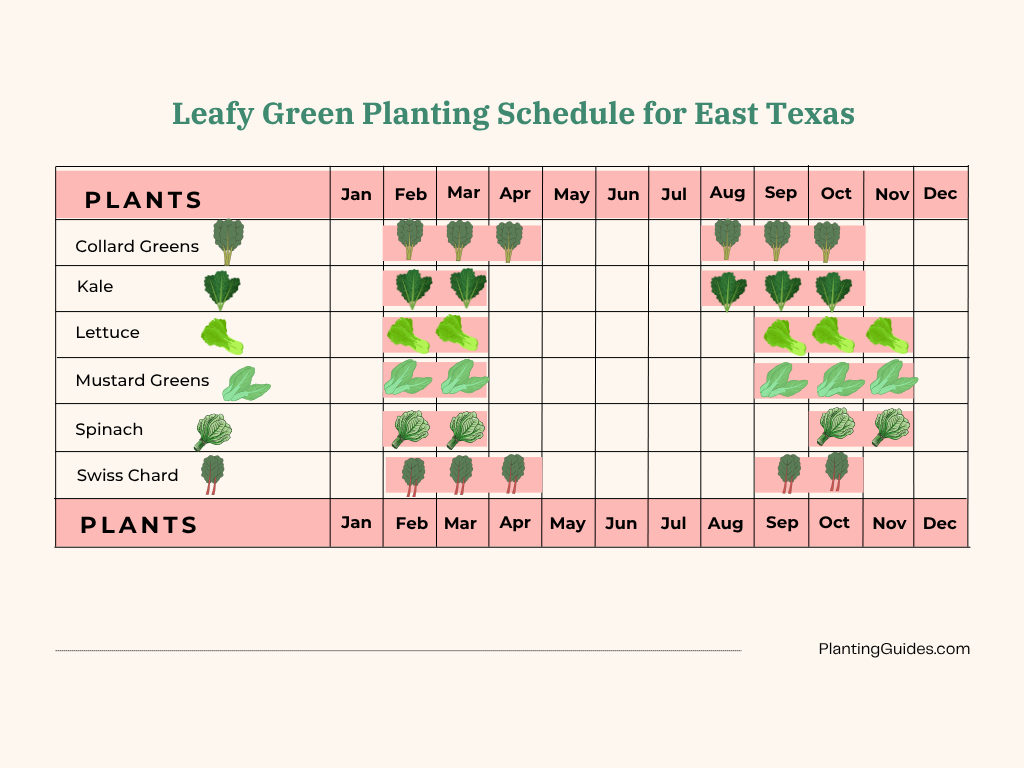
In spring and fall, protect your greens from sudden heat by giving them some shade or covering the soil with mulch so they don’t start flowering too early.
Don’t plant all your seeds at once, sow a few every 2–3 weeks. This way, all the plants don’t grow and finish at the same time, and you will get a steady harvest instead of everything ready at once.
Vegetables Planting Schedule Chart for East Texas
East Texas has two main times when vegetables grow well, early spring and late summer to fall. Spring is better for crops that take longer to grow like tomatoes and corn, while fall is great for leafy greens and root vegetables.
Always check your local weather to know your soil temperature and frost dates for better gardening results.
| Vegetable | Best Planting Time | Planting Method | Transplanting Time | First Harvest | Variety Recommendations |
|---|---|---|---|---|---|
| Tomatoes | Mar–Apr | Start indoors | After frost (late Mar) | 60–90 days | Celebrity, Juliet, Cherokee Purple |
| Peppers | Mar–Apr | Start indoors | Late Mar–Apr | 65–90 days | Jalapeño, Bell, Banana |
| Eggplant | Mar–Apr | Start indoors | Apr | 70–85 days | Black Beauty, Fairy Tale |
| Okra | Apr–Jun | Direct sow | N/A | 50–60 days | Clemson Spineless |
| Bush Beans | Mar–May, Aug | Direct sow | N/A | 50–60 days | Contender, Blue Lake |
| Corn | Mar–Apr | Direct sow | N/A | 60–90 days | Silver Queen, Peaches & Cream |
| Squash | Mar–May, Aug | Direct sow | N/A | 45–55 days | Yellow Crookneck, Zucchini |
| Cucumbers | Mar–May, Aug | Direct sow | N/A | 50–60 days | Straight Eight, Marketmore |
| Carrots | Jan–Feb, Sep–Nov | Direct sow | N/A | 60–75 days | Danvers, Nantes |
| Beets | Feb–Apr, Oct–Nov | Direct sow | N/A | 50–70 days | Detroit Dark Red, Chioggia |
| Onions (sets) | Jan–Feb | Bulb sets | N/A | 100–120 days | Texas SuperSweet |
| Potatoes | Jan–Feb | Cut seed potatoes | N/A | 80–110 days | Yukon Gold, Red LaSoda |
Visual Chart:
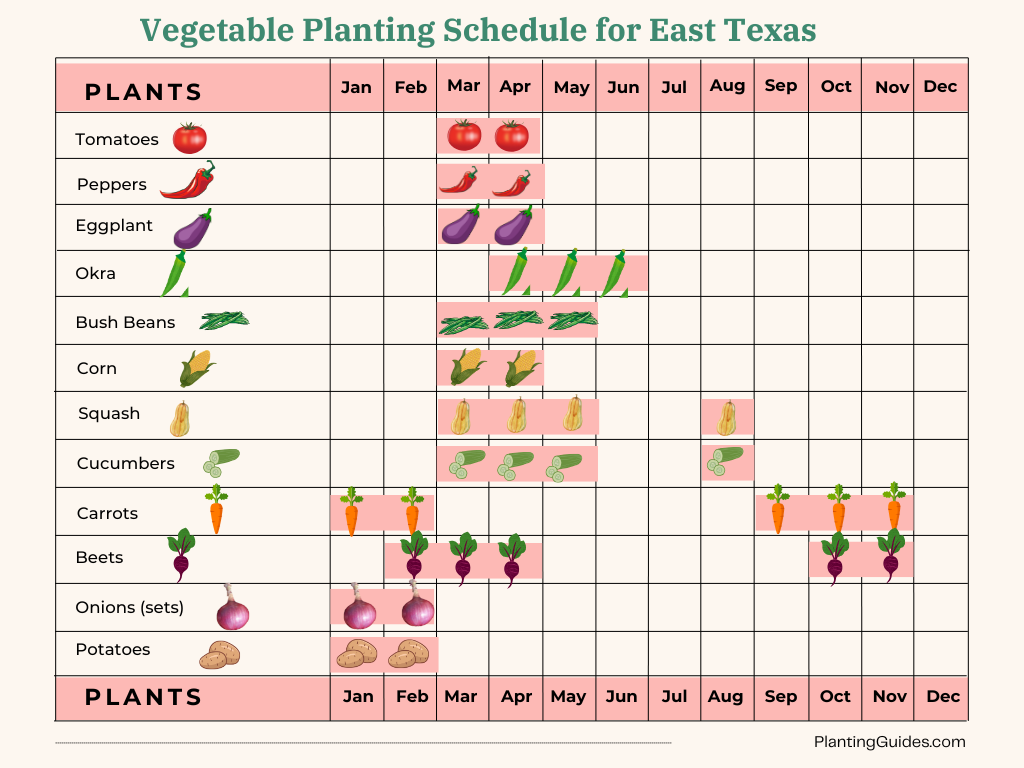
Water your vegetables regularly, especially when they are young, and cover them in early spring to protect them from frost.
Plant only after the last frost and make sure the soil is warmer than 60°F, cold soil can slow down warm-season crops like tomatoes, peppers, eggplant, etc.
Also, put mulch on top of the soil, it keeps the ground cool, holds in moisture, and helps your plants deal with the hot East Texas weather.
Fruits & Berries
East Texas is a great place for fruit trees and berries, especially the ones that need cold weather to grow well. The best time to plant them is in late winter, when the plants are still sleeping (dormant).
Fruit trees take time to grow and give fruit, but berries like strawberries and blackberries grow faster and start giving fruit quickly.
| Fruit/Berry | Best Planting Time | Planting Method | Transplanting Time | First Harvest | Variety Recommendations |
|---|---|---|---|---|---|
| Strawberries | Nov–Dec | Bare-root or plugs | N/A | 4–6 months | Chandler, Albion |
| Blackberries | Jan–Feb | Bare-root / transplant | N/A | 1 year | Natchez, Kiowa |
| Blueberries | Dec–Feb | Container or bare-root | N/A | 1–2 years | Tifblue, Brightwell |
| Figs | Jan–Mar | Bare-root / transplant | N/A | 1–2 years | Celeste, Texas Everbearing |
| Peaches | Jan–Feb | Bare-root | N/A | 2–3 years | Redskin, Harvester |
| Apples | Jan–Feb | Bare-root | N/A | 2–3 years | Anna, Dorsett Golden |
| Pears | Jan–Feb | Bare-root | N/A | 3–4 years | Moonglow, Kieffer |
| Grapes (bunch) | Jan–Feb | Bare-root | N/A | 2–3 years | Champanel, Blanc du Bois |
| Muscadine Grapes | Jan–Feb | Bare-root | N/A | 2–3 years | Carlos, Noble |
| Plums | Jan–Feb | Bare-root | N/A | 2–3 years | Methley, Morris |
| Pomegranates | Jan–Feb | Bare-root / transplant | N/A | 2–3 years | Wonderful, Granada |
| Persimmons | Jan–Feb | Bare-root | N/A | 3–4 years | Fuyu, Eureka |
| Jujube | Jan–Feb | Bare-root | N/A | 2–3 years | Li, Lang |
| Mayhaw | Jan–Feb | Bare-root | N/A | 3–4 years | Texas Star, Maxine |
| Mulberries | Jan–Feb | Bare-root | N/A | 2–3 years | Illinois Everbearing |
| Pawpaw | Jan–Feb | Container-grown | N/A | 4–5 years | Shenandoah, Susquehanna |
Visual Chart:
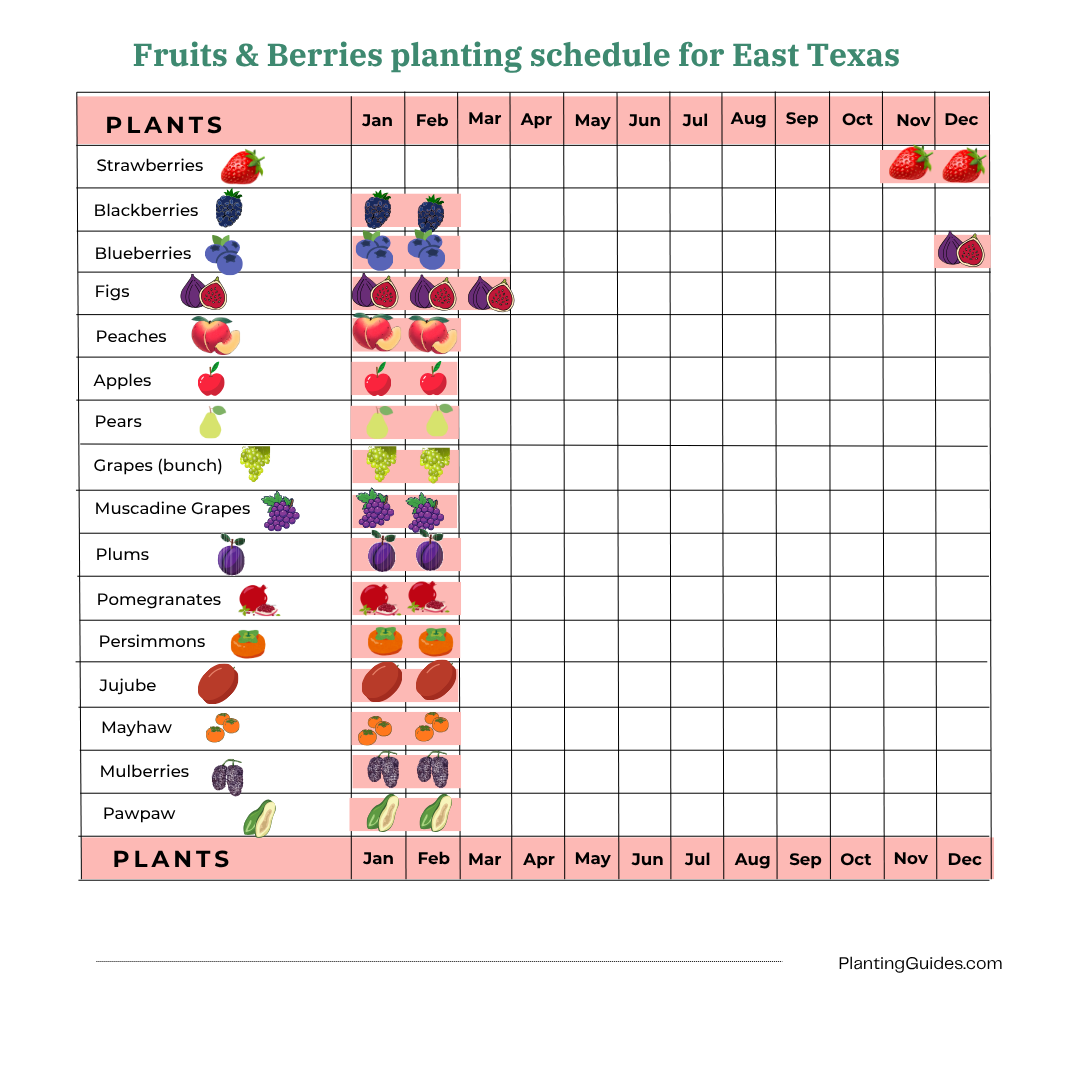
Always plant fruit trees where they will get lots of sunlight and the soil drains well. Mix compost or organic materials into the soil to improve the soil quality, and leave enough space between trees so they don’t spread disease.
Choose varieties based on your area’s winter temperatures, especially for apples, peaches, pears, and plums.
Use mulch and water regularly, especially during the hot East Texas summer, to help young plants grow strong.
Flowers
Flowers make your garden look bright and colorful, and they attract helpful pollinators like bees and butterflies. Plant heat-loving flowers in spring and cool-loving ones in fall.
If you want faster blooms, use seedlings, but planting seeds directly in the ground can save money.
| Flower Name | Best Planting Time | Planting Method | Transplanting Time | First Bloom | Perennial or Annual |
|---|---|---|---|---|---|
| Marigolds | Mar–May | Seeds / transplants | 2–4 weeks | 45–60 days | Annual |
| Zinnias | Mar–Jun | Direct sow | N/A | 60–75 days | Annual |
| Sunflowers | Mar–Jun | Direct sow | N/A | 70–90 days | Annual |
| Pansies | Oct–Nov | Transplants | N/A | 30–45 days | Annual (cool season) |
| Snapdragons | Oct–Nov | Seeds / transplants | 4–6 weeks | 60–85 days | Annual (cool season) |
| Petunias | Mar–Apr | Transplants | N/A | 45–60 days | Annual |
| Salvia (Mealycup or Autumn Sage) | Mar–May | Transplants | N/A | 60–90 days | Perennial |
| Lantana | Apr–May | Transplants | N/A | 60–90 days | Perennial |
| Black-eyed Susan | Mar–May | Seeds / transplants | 4–6 weeks | 60–90 days | Perennial |
| Coneflower (Echinacea) | Mar–May | Seeds / transplants | 4–6 weeks | 70–100 days | Perennial |
| Blanket Flower (Gaillardia) | Mar–May | Direct sow / transplant | 2–4 weeks | 60–90 days | Perennial |
| Coreopsis | Mar–May | Seeds / transplants | 4–6 weeks | 60–90 days | Perennial |
| Verbena (Native or Hybrid) | Mar–Apr | Transplants | N/A | 60–75 days | Perennial (some annuals) |
| Dianthus | Oct–Nov | Transplants | N/A | 60–80 days | Perennial / Biennial |
| Cosmos | Mar–May | Direct sow | N/A | 60–80 days | Annual |
| Celosia | Mar–May | Direct sow / transplant | 2–4 weeks | 60–75 days | Annual |
Visual Chart:
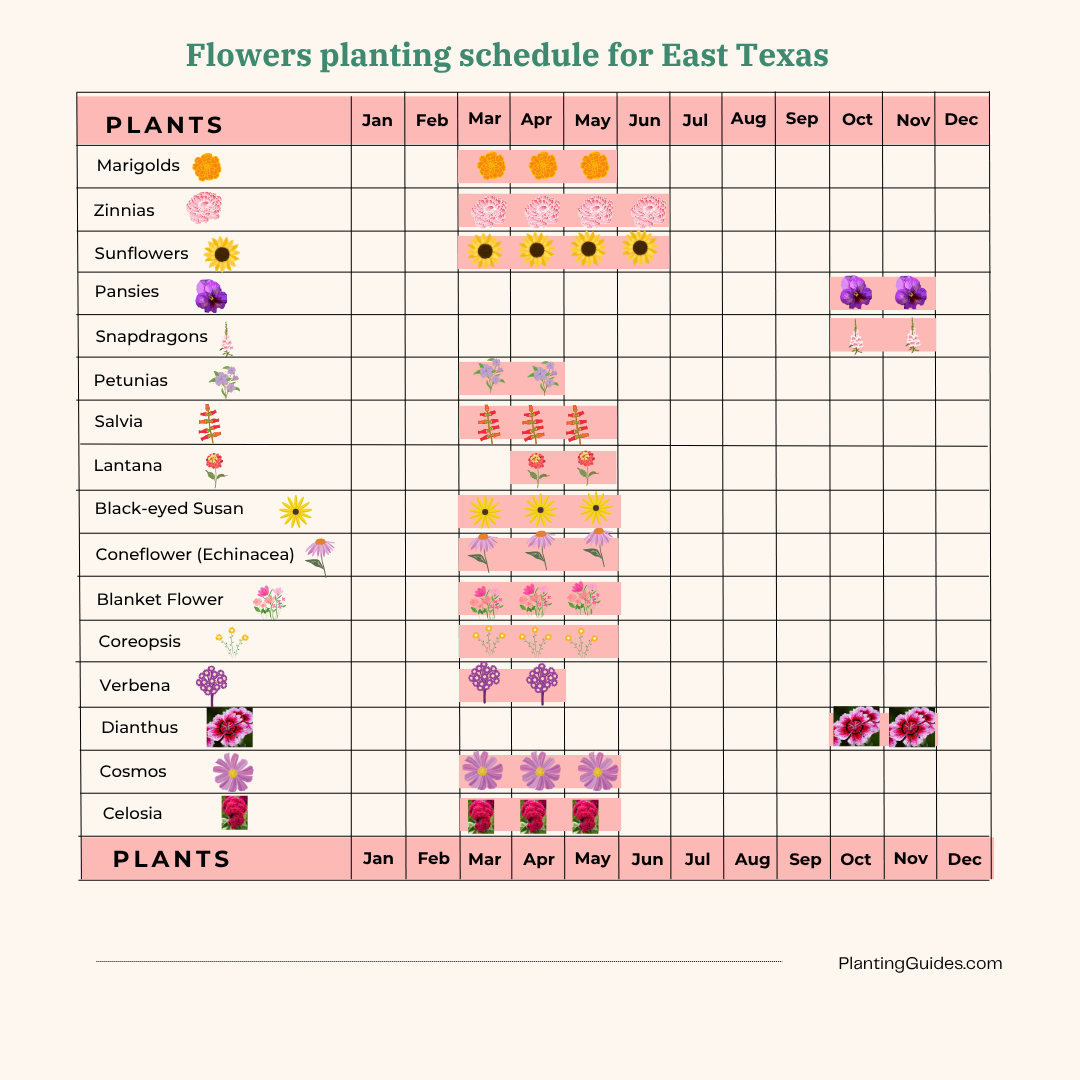
Plant warm-season flowers between March and May after the danger of frost is gone, once the soil has warmed up.
Keep cutting off the dried or dead flowers so the plant keeps making fresh blooms.
Plant cool-season flowers in October–November, before winter arrives, so they can develop strong roots and bloom early in spring.
Herbs for East Texas
Most herbs are actually very easy to grow in East Texas, especially if you give them enough sun and well-drained soil. Many herbs are perennials, which means they grow back on their own every year.
You can start them indoors in late winter or plant the seeds directly outside after the last frost.
| Herb | Best Planting Time | Planting Method | Transplanting Time | First Harvest | Variety Recommendations |
|---|---|---|---|---|---|
| Basil | Mar–Apr | Start indoors / direct | After last frost | 30–40 days | Genovese, Thai |
| Cilantro | Feb–Mar, Sep–Nov | Direct sow | N/A | 30–45 days | Slow Bolt, Santo |
| Dill | Feb–Mar, Sep–Nov | Direct sow | N/A | 40–50 days | Bouquet, Fernleaf |
| Parsley | Feb–Mar, Sep–Nov | Direct or transplant | 4–6 weeks | 70–90 days | Flat Leaf, Curled |
| Oregano | Mar–Apr | Transplant preferred | N/A | 60–90 days | Greek, Italian |
| Thyme | Mar–Apr | Transplant | N/A | 60–80 days | English, Lemon |
| Rosemary | Mar–Apr | Transplant | N/A | 80–100 days | Tuscan Blue, Arp |
| Mint | Feb–Apr | Transplant | N/A | 60–75 days | Spearmint, Peppermint |
| Chives | Feb–Mar | Direct or transplant | N/A | 60–80 days | Garlic Chives, Common |
| Sage | Mar–Apr | Transplant | N/A | 75–90 days | Berggarten, Garden Sage |
Visual Chart:

Grow mint in pots so it doesn’t spread everywhere. Most herbs like lots of sunlight and prefer soil that isn’t too wet, so try not to overwater them.
